On a website I saw some interesting elements and inspected them. This is how the element looked like:

The CSS definition:
.entry-meta .date a:before {
content: "\f303";
}
I know images can be embedded using the url property of content but in this case, there is no URL. What is this evil magic?